Measuring Air Speed
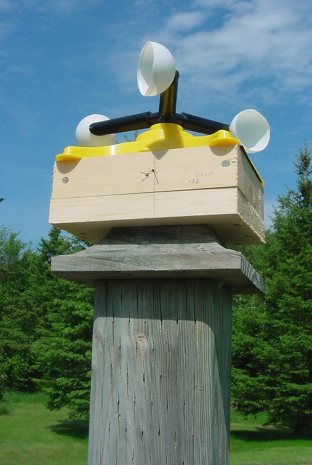
Hila Digital Anemometer

Hila Digital Anemometer
We designed this anemometer using a lawn sprinkler and ping-pong balls. The signal to the computer is generated when a rotating flag interrupts the light falling on a photoresistor.

Any three bladed lawn sprinkler will do. Make sure it rotates freely.
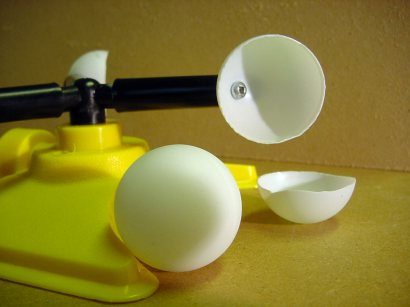
Slice some ping-pong balls in half. Attach the halves with short
screws to the ends of the blades.
You may have to use some glue to secure the balls. (Super Glue works
well)

Pull the base of the sprinkler to expose the rotating hub.
Cut a short dowel to slip into the hub.
(This example used a 1 cm dowel, 5 cm long)
The dowel should extend 2.5 cm past the base.
Attach a vinyl tape flag to the end of the dowel.
Flag: 1.5 cm long, 2 cm wide.

Insert dowel into hub.
Use Superglue to hold in place.
Be Careful: Superglue (CA) is dangerous!
Read safety instructions on container.
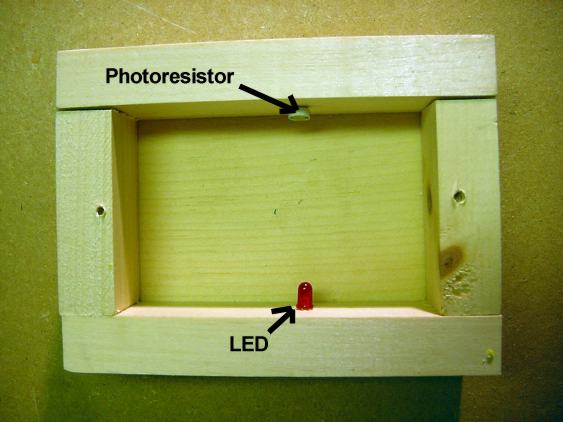
Build a base for the rotating assembly.
This base was constructed from 3/4" pine.
Outside dimensions: 10.5 cm X 14 cm.
Depth inside: 3 cm
Parts List (3/4" wood):
1 - 10.5 cm X 14 cm
2 - 3 cm X 6.5 cm
2 - 3 cm X 14 cm
Mount an LED and a Photoresistor as shown.
These electronic devices are mounted 1 cm off of center.
Dimensions vary with the size of the sprinkler.

The photoresistor is connected to pins 1 and 3 of the gameport.
(Link to more information about gameport connections)
The LED requires a 9 volt battery and a resistor (500 to 1000 Ohms)
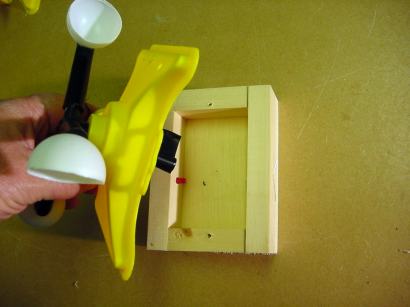
The rotating assembly sits on the base.
Make sure the tape flag is the right length to interrupt the light
flow to the photoresistor.

Use screws to hold the assembly together.
A black card may be needed to block external light from shining on
the sensor.
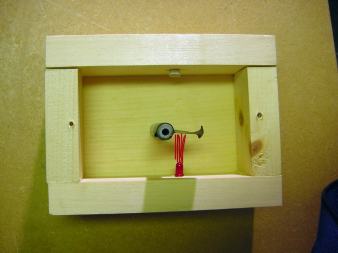
This image shows the rotating flag blocking the light.
When no light shines on the photoresistor the computer joystick port
senses a high resistance.
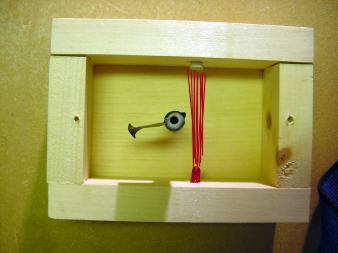
When wind blows causing the shaft to rotate,
light shines on the photoresistor, the computer joystick port senses
a low resistance.
The joystick port on a computer is a useful port for connecting resistive devices like CdS cells (photoresistors).
Check out connecting to the joystick port: Hila Computer Engineering:Joystick port
Here is some Qbasic code to test your anemometer with
Enter this code into Qbasic, you should see the numbers bounce up and
down as you rotate the shaft.
--------------------------------
CLS
DO
PRINT STICK(0)
LOOP
----------------------------------
It is possible to create more sophisticated programs for your anemometer.
Here is one in Qbasic created at our camp, it displays a bar graph moving
with changing air speed: windoka.bas
When prompted, save the file to a folder. The program must be run in
Qbasic.
This program worked well with a P3/700 MHZ computer. Different computers
may require some change to the code.
It is possible to create a program in VB that will monitor the wind
speed using this home made anemometer.
Check out the information on using the gameport
with Visual Basic.
If you create an interesting program to monitor wind speed, please
share it with us.
Project from Hila Science Camp